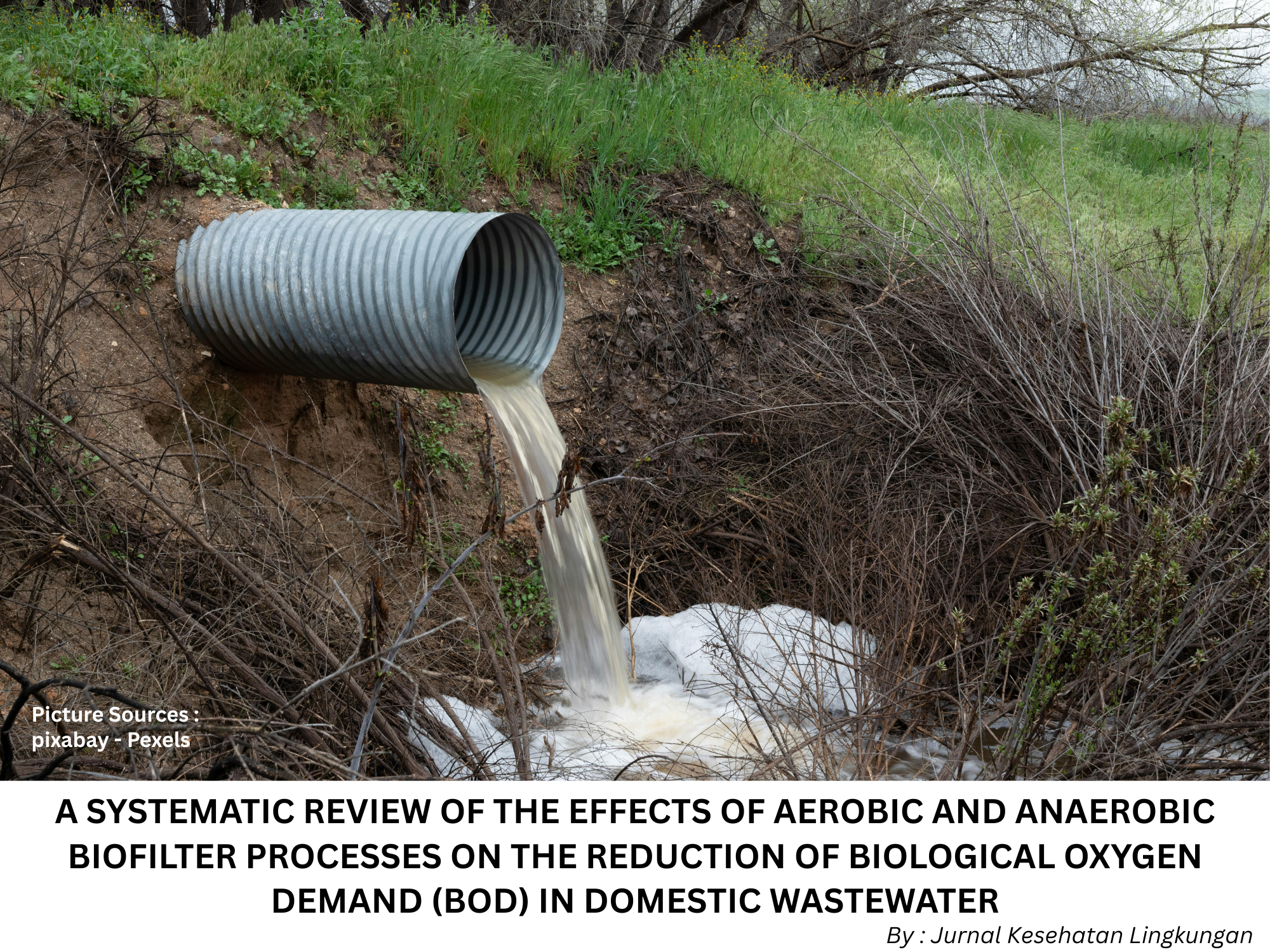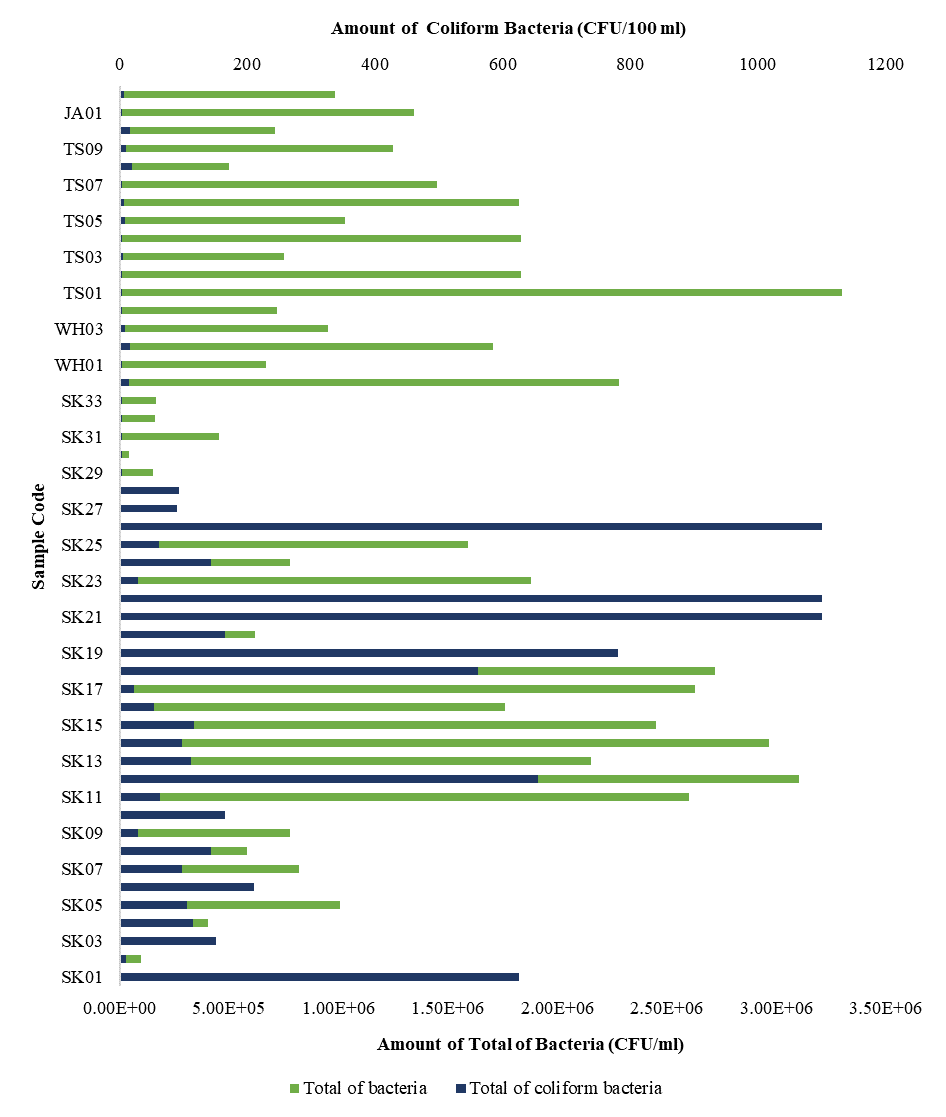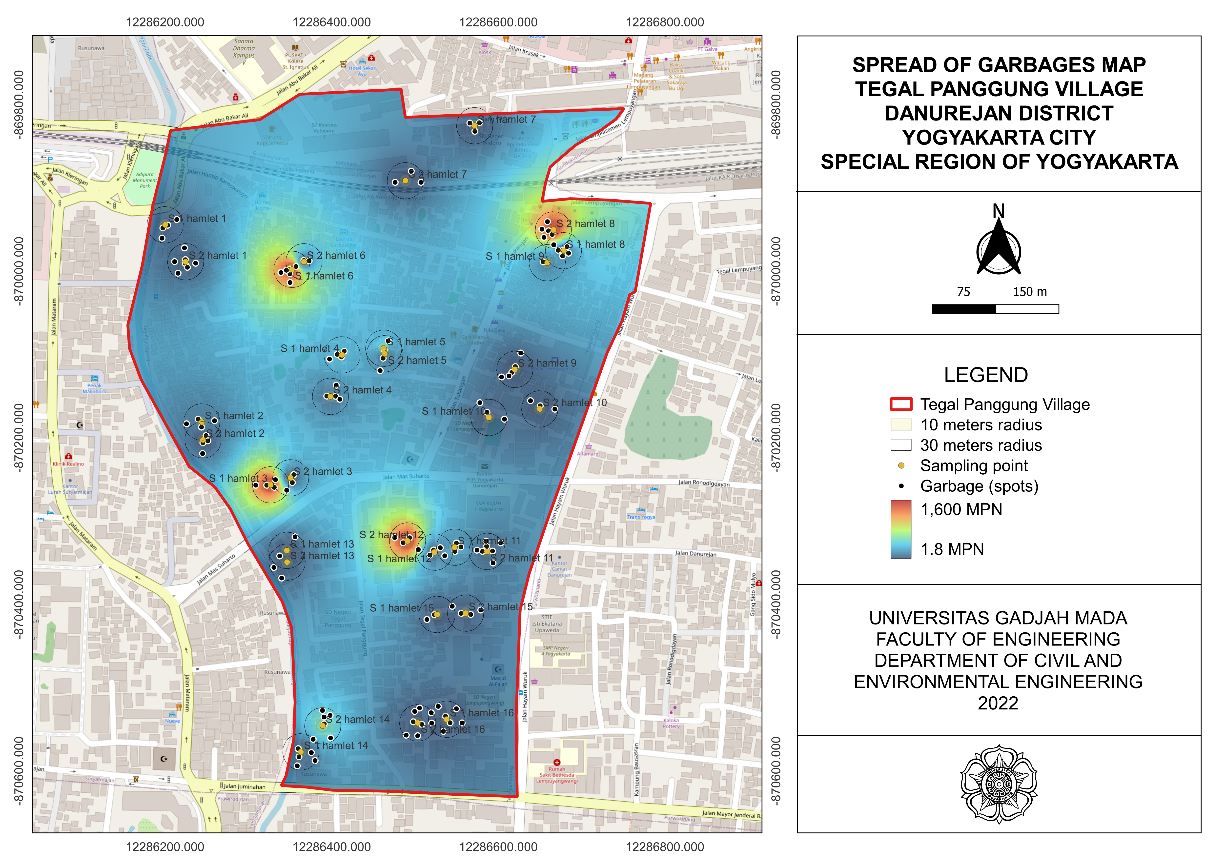A Systematic Review of the Effects of Aerobic and Anaerobic Biofilter Processes on the Reduction of Biological Oxygen Demand (BOD) in Domestic Wastewater

Downloads
Introduction: Domestic wastewater significantly contributes to environmental degradation due to its elevated Biological Oxygen Demand (BOD), indicating the concentration of organic contaminants that deplete oxygen in aquatic ecosystems. Biofilter-based treatment technologies, both aerobic and anaerobic, have emerged as sustainable alternatives; nonetheless, their comparative efficacy remains inadequately investigated. Discussion: This systematic study, adhering to PRISMA principles, evaluates the efficacy of aerobic and anaerobic biofilters in diminishing BOD levels in home wastewater. A thorough literature search utilizing Publish or Perish software across five databases Scopus, DOAJ, ScienceDirect, PubMed, and Google Scholar was conducted to find pertinent articles published from 2019 to 2025. Of the 1210 articles initially discovered, ten satisfied the inclusion criteria according to the PICOS framework. Research indicates that both aerobic and anaerobic systems markedly decrease BOD values. Aerobic biofilters provide quick organic matter decomposition and superior removal efficiency, while anaerobic systems are beneficial for energy conservation and diminished sludge production. Numerous studies underscore the improved effectiveness of hybrid or sequential biofilter systems, demonstrating a synergistic impact when both approaches are utilized together. Conclusion: Both aerobic and anaerobic biofilters effectively reduce BOD levels in home wastewater. Hybrid systems offer a notably advantageous solution by amalgamating the qualities of both methods. Future study must concentrate on refining operational parameters and assessing the long-term scalability of integrated biofilter technology to enhance sustainable wastewater management.
Sari, RA. Desain Instalasi Pengolahan Air Limbah Skala Komunal (Studi Kasus Desa Depok, Kabupaten Trenggalek, Jawa Timur). J Konversi. 2022;11(2):69–78.https://doi.org/10.22373/ijes.v1i1.4146
Syawfani R, Khairunnisa A, Farhan M. Pengolahan Limbah Cair Rumah Makan dengan Menggunakan Specialized Domestic Waste Water Mixed Treatment. J Teknol Lingkung Lahan Basah. 2024;12(2):361–368. https://doi.org/10.26418/jtllb.v12i2.76330
Akbar I. Pengolahan Limbah Minyak dan Lemak di Restoran Padang dengan Metode Fisik (Oil Grease Trap). J TechLINK. 2021;5(2):1–7. https://doi.org/10.59134/jtnk.v5i2.518
Harianja YE, Langga U, Hasibuan S, Sanjaya EH, Semarang J. Pemanfaatan dan Efektivitas Mikroorganisme dalam Pengolahan Air Limbah Domestik pada Beberapa Pengolahan Biologis. In: Proceeding of Life and Applied Science. 2025; 27–32. https://conference.um.ac.id/index.php/LAS/article/view/10140
Apema FD, Rahayu DE, Adnan F, Waryati W. Penggunaan Media Sarang Tawon dan Bioball Pada Biofilter Aerob Pada Pengolahan Limbah Cair Laundry. J Teknol Lingkung UNMUL. 2023;7(1):81-89. https://doi.org/10.30872/jtlunmul.v7i1.11809
Mualim M, Jubaidi J, Krisdiyanta K. Pengolahan Limbah Cair Domestik dengan Menggunakan Metode Biofilter Anaerob – Aerob. Mitra Raflesia (Journal Heal Sci). 2023;15(2):1-7. https://doi.org/10.51712/mitraraflesia.v15i2.281
Anjani AD. Analisis Parameter COD dan BOD Pengolahan Limbah Cair di RSUD Dr.Moewardi Metode Biofilter Aerob. In: Prosiding Seminar Nasional UNIMUS. 2022;. 1505–1516. https://prosiding.unimus.ac.id/index.php/semnas/article/view/1241/1242
Gangaraju G, Devi RU, Shah KJ. Chapter 1 Introduction to Conventional Wastewater Treatment Technologies : Limitations and Recent Advances. Materials Research Foundations. 2021;19(1):1-36. https://doi.org/10.21741/9781644901151-1
Utami A, Nugroho NE, Febriyanti SV, Nuur T. Evaluasi Air Buangan Domestik Sebagai Dasar Perancangan. J Presipitasi. 2019;16(3):172–179. https://doi.org/10.14710/presipitasi.v16i3.172-179
Subroto M, Prayogo W, Soewondo P, Setiyawan AS. Organic Removal in Domestic Wastewater Using Anaerobic Treatment System-MBBR with Flow Recirculation Ratio and Intermittent Aeration. Indones J Urban Environ Technol. 2022;5(3):296–316. https://doi.org/10.25105/urbanenvirotech.v5i3.12776
Ramadhan N. Eksplorasi Kualitas Air Limbah Domestik pada Kawasan Perhotelan. Kerja Praktek Teknik Lingkungan. 2024;1(1):9–16. https://journal.unusida.ac.id/index.php/kptl/en/issue/view/99
Sastrawijaya IGA, Supraba I, Syafri J, Ahmad M. Evaluasi Kinerja dan Potensi Pemanfaatan Efluen Instalasi Pengolahan Air Limbah Domestik Terpusat Skala Permukiman. 2022;14(22):16–30. https://doi.org/10.20885/jstl.vol14.iss1.art2
Balali-mood M, Naseri K, Tahergorabi Z, Khazdair MR. Toxic Mechanisms of Five Heavy Metals : Mercury, Lead, Chromium, Cadmium, and Arsenic. J Front i Pharmacol. 2021;12(4):1–19. https://doi.org/10.3389/fphar.2021.643972
Taufiqurrahman M, Ansori I, Noor MS, Haryati H, Assagaf A, Isa M. Lead (Pb) Exposure on Hemoglobin Levels and Decreasing Lung Function of Fuel Station Workers Banjarmasin. The Indonesian Journal of Occupational Safety and Health. 2024;13(12):271–277. https://doi.org/10.20473/ijosh.v13i3.2024.271-277
Sarwar S, Molla SR, Das S, Tammim L, Ahmed FF, Akter S. Algal Deterioration of PET (polyethylene terephthalate) Plastic Bottle in Combination with Physical and Chemical Pretreatments: A macrocosm Study. Environ Sustain Indic. 2024;21(100329):1-13. https://doi.org/10.1016/j.indic.2023.100329
Qatrunada SH, Mirwan M, Kamal MF. Evaluasi Instalasi Pengolahan Air Limbah (IPAL) Domestik pada Unit Pengolahan Biologis Terhadap Parameter BOD di Industri Pakan Ternak Surabaya. J Tek Mesin, Ind Elektro dan Inform. 2024;3(1):223–239. https://doi.org/10.55606/jtmei.v3i1.3282
Khalisa S, Ashari TM, Viena V, Ar-raniry S, Aceh B, Mekkah US, et al. Domestic Wastewater Treatment Plant Design (Case Study: Mita Mulia Hotel, Banda Aceh) 1. IJES Indones J Environ Sustain. 2023;1(1):27–33. https://doi.org/10.22373/ijes.v1i1.4146
Malik S, Kishore S, Dhasmana A, Kumari P, Mitra T, Chaudhary V, et al. A Perspective Review on Microbial Fuel Cells in Treatment and Product Recovery from Wastewater. Water (Switzerland). 2023;15(2):1-23. https://doi.org/10.3390/w15020316
Fikri A, Barus L. Biofilter Processing Method of Reducing the BOD/TSS, Oil/Fat, pH in Liquid Waste at an Orphanage. Int J Innov Creat Chang. 2020;13(2):205–216. https://www.ijicc.net/images/vol_13/Iss_2/SC25_Fikri_2020_E_R.pdf
Pudi A, Rezaei M, Signorini V, Andersson MP, Baschetti MG, Mansouri SS. Hydrogen Sulfide Capture and Removal Technologies: A Comprehensive Review of Recent Developments and Emerging Trends. Sep Purif Technol. 2022;298(121448):1-51. https://doi.org/10.1016/j.seppur.2022.121448
Zulfikar Z, Nasrullah N, Kartini K, Aditama W. Effect of Hydraulic Retention Time on the Levels of Biochemical Oxygen Demand and Total Suspended Solid with Simple Integrated Treatment as an Alternative to Meet the Household Needs for Clean Water. Open Access Maced J Med Sci. 2022;10(4):6–11. https://doi.org/10.3889/oamjms.2022.7828
Yulianto A. Rancang Bangun Biofilter untuk Pengolahan Limbah Cair Kegiatan Sentra Wisata Kuliner di Kecamatan Tambaksari , Kota Surabaya. Al-Ard J Tek Lingkung. 2021;6(2):86–95. https://doi.org/10.29080/alard.v6i2.1175
Lestari YDM. Penurunan Kadar BOD, COD dan Total Coliform dengan Penambahan Biokoagulan Biji Pepaya (Carica Papaya L) (Studi pada Limbah Cair Domestik Industri Baja di Surabaya Tahun 2020). J Kesehat Lingkung. 2021;18(1):49–54. https://doi.org/10.31964/jkl.v18i1.288
Barkah R, Pinanggih J, Ratri D, Nengse S, Utama T, Hakim A. Perencanaan Instalasi Pengolahan Air Limbah Domestik dengan Kombinasi Unit Biofilter Aerobik dan Adsorpsi Karbon Aktif Kantor Pusat PT. Pertamina Marketing Operation Region (MOR) V Surabaya. J Tek Lingkung. 2021;7(1):103–119. https://doi.org/10.20527/jukung.v7i1.10821
Abdulgani H. Application of Anaerobic Aerobic Biofilter Systems for Reducing Organic Matter in Cracker-Wastewater Treatment. J Presipitasi. 2025;22(1):109–123. https://doi.org/10.14710/presipitasi.v22i1.109-123
Deena SR, Kumar G. Efficiency of Various Biofilm Carriers and Microbial Interactions with Substrate in Moving Bed-Biofilm Reactor for Environmental Wastewater Treatment. Bioresour Technol. 2022;359(127421):1-15. https://doi.org/10.1016/j.biortech.2022.127421
Sigit P, Sitogasa A, Kurniawati E, Novembrianto R. Sistem Pengolahan dan Pemanfaatan Air Limbah Domestik (Studi Kasus Pada PT. X). J Ekol Masy dan Sains. 2023;4(1):14–20. https://doi.org/10.55448/ems.v4i1.75
Bafrani AH, Mirbagheri S. Investigating the Effect of Hydraulic Residence Time, Artificial Aeration and Plants Presence on Different Constructed Wetland Designs Treating Oil Industry Effluent. J Environ Manage. 2024;370(122348):1-11. https://doi.org/10.1016/j.jenvman.2024.122348
Halim HE. Pengaruh Waktu terhadap Penurunan BOD, COD, dan TSS Limbah Rumah Makan menggunakan Biofilter Anaerob. Enviro. 2023;(72):1–9. https://doi.org/10.59134/jtnk.v3i2.497
Nathaniel M, Arbaningrum R. Analisis Desain Hidrolik IPAL Sistem Biocord dalam Mengatasi Pencemaran Air pada Danau Duta Harapan. Jurnal Proy Tek Sipil. 2021;4(2):72–82. https://doi.org/10.14710/potensi.2021.11703
Sugito S, Ratnawati R, Afiafani H. Hybrid Anaerobic Baffled Reactor for Removal of BOD and Phosphate Concentration in Domestic Wastewater. Indones J Urban Environ Technol. 2021;5(1):14–27. https://doi.org/10.25105/urbanenvirotech.v5i1.10571
Deng S, Chen J, Chang J. Application of Biochar as an Innovative Substrate in Constructed Wetlands/Biofilters for Wastewater Treatment: Performance and Ecological Benefits. J Clean Prod. 2021;293(126156):1-14. https://doi.org/10.1016/j.jclepro.2021.126156
Fardian E. Teknologi Biofilter sebagai Pengolahan Air Limbah Rumah Sakit. Environmental Eng J ITATS. 2022;2(1):28–34. https://doi.org/10.31284/j.envitats.2022.v2i1.2899
Higgins JPT, Green S, Ben VDA. Cochrane Handbook for Systematic Reviews of Interventions Version 6.4. United States of America: Wiley Blackwell; 2023. https://www.cochrane.org/authors/handbooks-and-manuals/handbook
Gurusamy K. A Guide to Performing Systematic Reviews of Health and Disease. London, United Kingdom: UCL PRESS; 2025. https://doi.org/10.2307/jj.18255586
Haddaway NR, Page MJ, Pritchard CC, McGuinness LA. PRISMA2020: An R Package and Shiny App for Producing PRISMA 2020-Compliant Flow Diagrams, with Interactivity for Optimised Digital Transparency and Open Synthesis. Campbell Syst Rev. 2022;18(2):1-12. https://doi.org/10.1002/cl2.1230
Higgins JPT, Green S, Ben VDA. Cochrane Handbook for Systematic Reviews of Interventions. International Coaching Psychology Review; 2020. https://doi.org/10.53841/bpsicpr.2020.15.2.123
Bhattacharya R, Mazumder D. Simultaneous Nitrification and Denitrification in Moving Bed Bioreactor and Other Biological Systems. Bioprocess Biosyst Eng. 2022;44(4):635–652. https://doi.org/10.1007/s00449-020-02475-6
Apriani D. Perencanaan Pengolahan Limbah Cair di Pasar Mentari dengan Metode Anaerob Biofilter. J Teknol Lingkung Lahan Basah. 2024;12(3):771–779. https://doi.org/10.26418/jtllb.v12i3.78925
Loh ZZ, Zaidi NS, Syafiuddin A, Yong EL, Boopathy R. Applied Sciences Shifting from Conventional to Organic Filter Media in Wastewater Biofiltration Treatment : A Review. MDPI. 2021;11(8650);1-17. https://doi.org/10.3390/app11188650
Mangarengi. The Use of Polymeric Materials of Polyethylene Terephthalate (PET) and Polypropylene (PP) as the Media of Anaerobic-Aerobic Bioreactors in Treating Wastewater from the Tofu industry. IOP Conference Series: Earth and Environmental Science. 2023;1268(012007):1-13. https://doi.org/10.1088/1755-1315/1268/1/012007
Dewi IU, Azizah R. Effectiveness of Wastewater Treatment Installation and Liquid Waste Quality in Dr. Soetomo General Hospital, Surabaya. J Kesehat Lingkung. 2022;14(1):45–54. https://doi.org/10.20473/jkl.v14i1.2022.45-54
Sutanhaji, Alexander T. Evaluasi Kinerja Instalasi Pengolahan Air Limbah (IPAL) Domestik di Inkubator Bisnis Permata Bunda Kota Bontang. J Sumberd Alam dan Lingkung. 2021;8(68):65–73. https://doi.org/10.21776/ub.jsal.2021.008.02.2
Surono A, Suprapto S, Arga AD, Manullang AA. The Effect of Aeration on Aerobic Biofilter Using Polyethylene Terephthalate Media for Chicken Slaughterhouse Liquid Waste. IPTEK J Eng. 2023;9(3):96-100. https://doi.org/10.12962/j23378557.v9i3.a18211
Abdelfattah A, Ali SS, Ramadan H, El-Aswar EI, Eltawab R, Ho SH, et al. Microalgae-based Wastewater Treatment: Mechanisms, Challenges, Recent Advances, and Future Prospects. Environ Sci Ecotechnology. 2023;13(100205):11-27. https://doi.org/10.1016/j.ese.2022.100205
Susilawati D, Wulaningum PD, Putri AR, Ningsih ER. Organic Waste Management Through Stacked Buckets, Kitchen Waste (Losida) and Training in Organic Waste Crafts Based on Creation Economy Creative for Family Economy Improvement. Proceeding Int Conf Technol Community Environ Dev. 2023;1(2):553–565. https://doi.org/10.18196/ictced.v1i2.71
Putri RA, Julianti S. Optimalisasi Sistem Pengolahan Air Limbah Domestik Berbasis Biofilter Anaerob-Aerob di Permukiman Padat Penduduk. J Sci Technol Alpha. 2025;1(2):42–47. https://doi.org/10.70716/alpha.v1i2.173
Gilalom F, Utomo KP. Pengolahan Limbah Cair Rumah Makan dengan Biofilter Aerob Menggunakan Media Filter Bio-Yarn. Rekayasa Lingkung Trop. 2021;2(1):1–10. https://jurnal.untan.ac.id/index.php/jurlis/article/view/46603
Diadon A, Timpua TK, Kabuhung A. Efektivitas Biofilter Anaerob Aerob Media Bata Styrofoam Sistem Aliran ke Atas dalam Menurunkan Kadar BOD, COD dan Coliform pada Air Limbah Rumah Sakit Prof. Dr. V.L. Ratumbuysang Manado. J Kesehat Lingkung. 2019;9(1):26–39. https://doi.org/10.47718/jkl.v9i1.640
Lee C, Jang YC, Choi K, Kim B, Song H, Kwon Y. Recycling, Material Flow, and Recycled Content Demands of Polyethylene Terephthalate (PET) Bottles towards a Circular Economy in Korea. Environ - MDPI. 2024;11(2):1–14. https://doi.org/10.3390/environments11020025
Priyadi, Diah N. The Effect of Addition of Plastic Waste and Styrofoam Waste Against Powerful Concrete Brick Press. In: Proceedings of the First International Conference on Health, Social Sciences and Technology (ICoHSST 2020). 2021;521:212–215. https://doi.org/10.2991/assehr.k.210415.045
Fadzry N, Hidayat H. Analysis of COD, BOD, and DO Levels in Wastewater Treatment Instalation (IPAL) at Balai Pengelolaan Infrastruktur Air Limbah dan Air Minum Perkotaan Dinas PUP-ESDM Yogyakarta. IJCR-Indonesian J Chem Res. 2020;5(2):80–89. https://doi.org/10.20885/ijcer.vol5.iss2.art5
Daroini AT. Analisis BOD (Biological Oxygen Demand) di Perairan Desa Prancak Kecamatan Sepulu, Bangkalan. Juvenil. 2020;1(4):558–566. https://doi.org/10.21107/juvenil.v1i4.9037

This work is licensed under a Creative Commons Attribution-NonCommercial-ShareAlike 4.0 International License.
1. Copyright of all journal manuscripts is held by the Jurnal Kesehatan Lingkungan.2. Formal legal provisions to access digital articles of electronic journal are subject to the provision of the Creative Commons Attribution-ShareAlike license (CC BY-NC-SA), which means that Jurnal Kesehatan Lingkungan is rightful to keep, transfer media/format, manage in the form of databases, maintain, and publish articles.
3. Published manuscripts both printed and electronic are open access for educational, research, and library purposes. Additionally, the editorial board is not responsible for any violations of copyright law.
JKESLING by UNAIR is licensed under a Creative Commons Attribution-ShareAlike 4.0 International License.







































